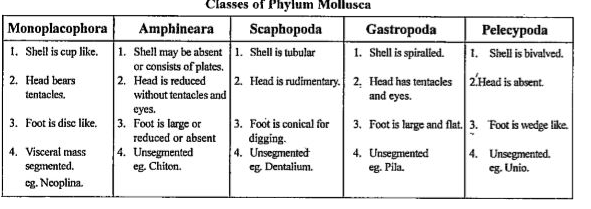Escribe important characters of phylum Annelida and name its classes with few characters.Solution in Punjabi
Video Solution
Text Solution
Mollusca are soft bodied, shelled animals. These include over 60,000 species and is the second largest phylum. Neopilina, a living fossil of this phylum was discovered in 1952. It has metameric segmentation. It has a trochophore larva like of Annelida. It indicates that molluscs have descended from annelids. It is a connecting link between molluscs and annelids. Characteristics. Molluscs have following characters :
1. Habitat. These are aquatic, mostly marine, few fresh water or may be terrestrial animals.
2. Germ layers. These are triploblastic.
3. Body cavity. Body cavity is haemocoel. Coelom is greatly reduced and represented mainly by pericardial cavity, gonadial cavity and kidneys.
4. Symmetry. These are mostly unsegmented, bilaterally symmetrical or may be asymmetrical.
5. Level of organisation. They have organ system level of organisation,
6. Body division, Body has head, foot and visceral mass.
7. Mantle. Mantle or pallium is a fold of body wall. It encloses a space, the mantle or pallial cavity. Mantle is also a respiratory organ.
8. Body shell. Body is protected by an exoskeletal calcareous shell which may be univalve or bivalve. It is secreted by the mantle. The shell may be internal or reduced or even absent.
9. Digestive system. Alimentary canal is complete with hepatopancreas, a rasping organ called radula is present in buccal mass having transverse rows of teeth. The anus opens in the mantle cavity.
10. Circulatory system. It is open type. Heart is pulsatile with one or two auricles and one ventricle. There are few arteries which open into sinuses, Blood contains amoebocytes and hemocyanin pigment.
11. Respiratory system. Respiration occurs by gills called ctenidia or lungs or mantle.
12. Excretory system. Excretion is by kidneys, Keber.s organs etc. Animals are either ammonotelic or ureotelic.
13. Nervous system. - It consists of cerebral, pedal and visceral ganglia which are interconnected by commissures and connectives.
14. Sense organs. These include eyes, statocysts and receptors for sight, balance, touch, smell and taste.
15. Reproduction. Molluscs may be dioecious, or monoecious having gonads with gonoducts.
16. Fertilization and development. Fertilization may be external or internal. Development is direct or through trochophore larva or glochidium larva, Asexual reproduction is absent:

|
Updated on:21/07/2023
Similar Questions
Describe the important characters of animals belonging to phylum annelida.
01:31View SolutionWrite the general characters of phylum Annelida.
03:17View SolutionWrite the general characters of phylum Annelida.
03:17View SolutionDescribe important characters of phylum Porifera and its different classes.
View SolutionDescribe important characters of phylum coelenterata and name its classes with examples.
View SolutionEscribe important characters of phylum Annelida and name its classes with few characters.
02:28View SolutionDescribe different characters of phylum Arthropoda, name its classes with examples.
View Solution

